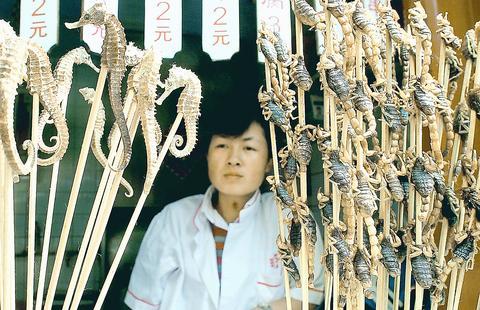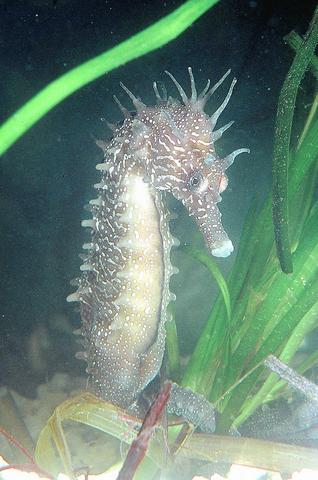Seahorses are their own worst enemy.
Fished to the point of extinction for the traditional Chinese medicine market, they mate for life and their unwillingness to seek new partners after being separated has done little to improve their chances of survival.
One of their better hopes for conservation may lie in the unlikeliest of places -- a ramshackle shed perched on the edge of the Atlantic Ocean.

PHOTO: REUTERS
Seahorse Ireland says its goal is to help save the species by cultivating seahorses born in captivity for the growing aquarium market.
"We want to make people aware that the captive-bred seahorse is a much better buy," said production manager Ken Maher, from the makeshift laboratory in Connemara, west Ireland.
"There's no deleterious effect on the environment and the seahorse will survive and flourish in your tank."

PHOTO: REUTERS
Seahorses are no ordinary sea creatures, notwithstanding their monogamy which is highly unusual for the animal kingdom. It is the male who receives eggs from his female partner and fertilizes them himself.
"The female swims up to her chosen male partner and the two change color as they dance around each other for hours in an elaborate courtship ritual," said Maher.
After receiving eggs from the female and fertilizing them himself, the male is pregnant for about three weeks before giving birth.
Captive-bred
The low-cost technology pioneered by Seahorse Ireland could be transferred to poorer parts of the world where seahorse stocks are fast becoming depleted.
Next year, a ban on international trade in seahorses, unless they are captive-bred or for scientific purposes, is due to come into operation, a move likely to cripple the livelihoods of thousands of dependent fishermen.
"Other conservation bodies try to say `this is a sanctuary, no fishing is allowed here,' and try to get locals to make arts and crafts instead," Maher said.
"But these people are fishermen who want to live near the sea. I know I could not switch to making arts and crafts if I was in their position."
If no alternative was provided, the trade would simply go underground, Maher said.
An estimated 40 million seahorses a year are taken from the wild for traditional Chinese medicine in which they are used as an aphrodisiac as well as a range of ailments including heart disease.
Demand has risen in recent years to such an extent that seahorses retail for about US$1,900 a kilogram in Asia, almost the price of gold.
A further one million are fished for the curio trade because seahorses retain their shape and color when dried.
The pet trade takes another one million, but very few survive beyond a few months or so without live food.
Frozen food
That's where Seahorse Ireland comes in -- it trains captive-born seahorses to get used to frozen food.
"Once we train them to take frozen food, they can be sent all over the world," said Maher.
Set up three years ago by Maher and his fellow marine biologist Kealan Doyle, Seahorse Ireland has two key advantages right on its doorstep.
First, the larger of the two seahorse species local to Ireland, the spiny seahorse, can be found in seagrass beds in and around nearby Kilkieran Bay.
In addition, the west coast of Ireland offers an abundance of zooplankton enriched by nutrients from the Gulf Stream, and the company has developed a system to extract and freeze this food.
Maher dismissed criticism from some environmentalists that breeding seahorses in captivity will serve only to boost demand, heaping more pressure on rapidly-declining stocks.
Capable of spawning 200 offspring at a go in the wild, with the right conditioning seahorses could breed closer to 1,000 juveniles, Maher said.
The company aims to sell seahorses for the pet market, retailing from 200 euros each, over the Internet, to be dispatched for next-day delivery.
"Seahorses travel quite well in tightly packed bags, with oxygen, just like goldfish," Maher said.
Sales are forecast at around 30,000 next year and around 70,000 the year after. Over time, Maher said there were plans to open a visitor center, using the seahorse as an icon for other endangered species.
"We will use it as a focus for conservation because it's not just the panda in China or the river dolphin in India that are in need of help," he said.

On April 26, The Lancet published a letter from two doctors at Taichung-based China Medical University Hospital (CMUH) warning that “Taiwan’s Health Care System is on the Brink of Collapse.” The authors said that “Years of policy inaction and mismanagement of resources have led to the National Health Insurance system operating under unsustainable conditions.” The pushback was immediate. Errors in the paper were quickly identified and publicized, to discredit the authors (the hospital apologized). CNA reported that CMUH said the letter described Taiwan in 2021 as having 62 nurses per 10,000 people, when the correct number was 78 nurses per 10,000

As we live longer, our risk of cognitive impairment is increasing. How can we delay the onset of symptoms? Do we have to give up every indulgence or can small changes make a difference? We asked neurologists for tips on how to keep our brains healthy for life. TAKE CARE OF YOUR HEALTH “All of the sensible things that apply to bodily health apply to brain health,” says Suzanne O’Sullivan, a consultant in neurology at the National Hospital for Neurology and Neurosurgery in London, and the author of The Age of Diagnosis. “When you’re 20, you can get away with absolute

May 5 to May 11 What started out as friction between Taiwanese students at Taichung First High School and a Japanese head cook escalated dramatically over the first two weeks of May 1927. It began on April 30 when the cook’s wife knew that lotus starch used in that night’s dinner had rat feces in it, but failed to inform staff until the meal was already prepared. The students believed that her silence was intentional, and filed a complaint. The school’s Japanese administrators sided with the cook’s family, dismissing the students as troublemakers and clamping down on their freedoms — with

As Donald Trump’s executive order in March led to the shuttering of Voice of America (VOA) — the global broadcaster whose roots date back to the fight against Nazi propaganda — he quickly attracted support from figures not used to aligning themselves with any US administration. Trump had ordered the US Agency for Global Media, the federal agency that funds VOA and other groups promoting independent journalism overseas, to be “eliminated to the maximum extent consistent with applicable law.” The decision suddenly halted programming in 49 languages to more than 425 million people. In Moscow, Margarita Simonyan, the hardline editor-in-chief of the